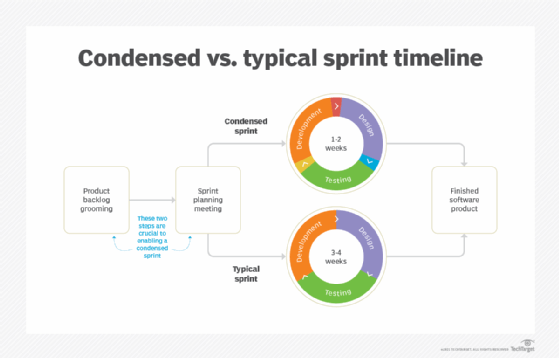
Condensed Agile sprint timeline pros and cons
Is a condensed Agile sprint possible for your dev team? Here's how to shave off some sprint time and what perils to look out for in a smaller Agile sprint window.
Sprints are at the heart of Agile software development. Software development teams plan their work around sprints that they've identified and prioritized for the importance of their project.
Typically, Agile sprint timelines last three to four weeks. This allows for the team to design, develop and test the software. During these sprints, software development teams are supposed to envision the project as a whole to create a more efficient delivery, while at the same time avoiding the "dump-and-run" mentality that can leave customers with a defective, bug-filled product.
From a personnel perspective during a sprint, team members are supposed to share the same goal of creating better code at a quicker, more delivery-ready pace. Let's dive into Agile sprints and discuss what a condensed Agile sprint timeline can mean for the team and product.
Agile sprinting 101
In an Agile sprint, the development team performs the work based on stories, which are small pieces of features and functions. Stories should be brief and represent only a single change or a small set of interrelated changes to keep a team member's focus on a tiny portion of the project.
Before the sprint begins, the entire development team works together to develop a sprint plan. Developers will need to keep design considerations in mind when they groom user stories, and then estimate how much time they will need to complete the assigned story tasks. The teams will then plan their future sprints by reviewing the list of stories and dividing them into sprints for developers to work on.
One important member of an Agile sprint is the product manager. They're responsible for ensuring that stories get on the sprint board, and they guarantee the team grooms, updates and estimates stories as needed during or before sprint planning. If some stories have a higher importance, it's the product manager's job to prioritize these stories and make sure the work is completed before the next phase in development. Teams generally link and complete codependent stories within a sprint or two of each other.

Once the sprint begins, the team follows the work progress on the active sprint board and moves each story along the phases toward completion. For example, a developer picks up a story in their swimlane, codes and side tests. Once they complete the work, a QA professional picks up the story and validates that the code matches the story. If the story passes, then it's moved to either a "Done" phase or another post-QA state. If it fails to pass QA, the story is entered as defective or the QA member of the team returns the story to the development team for additional work.
This example Agile sprint workflow can be tailored to fit an organization's demands and processes. However, regardless of the development stages, it needs to be well defined before the sprint begins.
If the typical Agile sprint timeline is too long, it's possible to condense the sprint to a shorter timeframe, such as a week or two. Agile is flexible and sprint timelines aren't set in stone, so they can be any length. When a team considers a shorter sprint timeline, it needs to evaluate the potential advantages and disadvantages.
Condensed Agile sprint timelines
Short sprints encourage team members to cooperate closely and communicate openly. Teams must constantly ask questions and rapidly propose design changes. It can be stressful to complete the work in a shorter Agile sprint timeline and include software testing. It doesn't matter if the testing is done together or separately because there's such a small window to complete a thorough software test.
Before an organization implements a condensed Agile sprint, the dev team should practice. For example, if developers make too many errors, the team should consider adding another day or two to see if that produces quality code.
It's possible to complete a one-week sprint if the work is properly planned and the team is composed of employees with a good rapport and strong communication skills.
It's extremely difficult for even the most cohesive team to get code from development, through testing and then deployment in five days. Even if development and testing go well, there's nearly always an issue in the deployment that needs correction. Late nights and stress take their toll on team members, and morale often takes a hit.
Sprint planning for condensed timelines
If a team completes a condensed sprint in one or two weeks, that success probably stems from excellent sprint planning. Development teams can't have huge user stories full of inconsistencies that generate dozens of questions. Stories must be detailed, clear and concise.
Other important factors in successful condensed sprint planning include backlog grooming and testing data quality. Backlog grooming sessions need to be an active exchange of questions, design considerations and decisions. Testing data needs to exist along with test environments that can be rapidly set up and ready to go.
During sprint planning, team members should pull in only the number of story points they expect to be able to complete. Along with the story layout, the team will need to factor in the time to fix defects found in testing and the testing time for each story. The team may also want to consider a rule that unless there's a severe defect or a critical bug, that it won't fix those until the next sprint.
However, that means the team will have a growing backlog of technical debt. This debt can rapidly fill in a sprint and too much could even necessitate a hardening sprint. Sprints frequently start to "roll" over and over until teams try to do three weeks of work in a week or two. If a team sees stories delayed from sprint to sprint, then it should consider extending the sprint length. Teams don't necessarily have to add another whole five days; they can start adding a day or two and see if that get things back on track.
Sprints are often challenging because work is frequently in an unknown state or the team needs to reconsider or rework designs. Testing may lag due to story complexity or the size of the testing effort.
The Agile method is about flexibility. Teams should experiment and determine the best sprint pace for their organization. If teams want to consider condensed sprints, they'll need to consider resource usage and if the team is ready for a smaller, more hectic work window. Keep track of bugs and defects and be careful of building up a technical debt that will take multiple future sprints to clean up.
The overall goals of a sprint are quality code and quick releases, but teams must find the pace that works best for them and their products.






